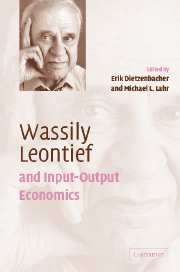Book contents
- Frontmatter
- Contents
- List of contributors
- List of figures
- List of tables
- Preface
- Part I Reflections on input-output economics
- Part II Perspectives of input-output economics
- 10 A neoclassical analysis of total factor productivity using input-output prices
- 11 What has happened to the Leontief Paradox?
- 12 The decline in labor compensation's share of GDP: a structural decomposition analysis for the United States, 1982 to 1997
- 13 An oligopoly model in a Leontief framework
- 14 Economies of plant scale and structural change
- 15 Technological change and accumulated capital: a dynamic decomposition of Japan's growth
- 16 Japan's economic growth and policy-making in the context of input-output models
- 17 Contributions of input-output analysis to the understanding of technological change: the information sector in the United States
- 18 How much can investment change trade patterns? An application of dynamic input-output models linked by international trade to an Italian policy question
- 19 Social cost in the Leontief environmental model: rules and limits to policy
- Subject index
- Author index
15 - Technological change and accumulated capital: a dynamic decomposition of Japan's growth
Published online by Cambridge University Press: 22 September 2009
- Frontmatter
- Contents
- List of contributors
- List of figures
- List of tables
- Preface
- Part I Reflections on input-output economics
- Part II Perspectives of input-output economics
- 10 A neoclassical analysis of total factor productivity using input-output prices
- 11 What has happened to the Leontief Paradox?
- 12 The decline in labor compensation's share of GDP: a structural decomposition analysis for the United States, 1982 to 1997
- 13 An oligopoly model in a Leontief framework
- 14 Economies of plant scale and structural change
- 15 Technological change and accumulated capital: a dynamic decomposition of Japan's growth
- 16 Japan's economic growth and policy-making in the context of input-output models
- 17 Contributions of input-output analysis to the understanding of technological change: the information sector in the United States
- 18 How much can investment change trade patterns? An application of dynamic input-output models linked by international trade to an Italian policy question
- 19 Social cost in the Leontief environmental model: rules and limits to policy
- Subject index
- Author index
Summary
Introduction
In this paper we evaluate technological progress using static and dynamic production linkages. Technologies of an activity are mutually interdependent through the market transactions of all the “produced” inputs. This implies that the production of one commodity is linked to that of all other commodities, both directly and indirectly, through intermediate transactions. Because of this, the change in a commodity's technological efficiency should be measured as the change in the economy's productivity induced by technology change in all linked activities. But production linkages between the commodity and the rest of the economy should not be evaluated simply through the static interdependent relationships among sectors. The dynamic interrelationship among sectors through the process of accumulating capital as produced factors of production should also be included.
The productivity of a sector in a specific period depends on its use of primary factors, such as labor and capital, as well as of intermediate inputs. The capital a sector uses is extracted from the capital accumulated through past investments. Prior investment is characterized by properties of technology during the periods when the accumulated capital was produced and invested. This means that past capital investment affects present production efficiency. In the traditional growth accounting framework, however, capital investments are measured as direct contributions to gross product with no direct link to technological progress. Hence, it would be interesting to isolate technological progress through the accumulation of these capital contributions, so that we could measure its effect on productivity.
Information
- Type
- Chapter
- Information
- Wassily Leontief and Input-Output Economics , pp. 256 - 293Publisher: Cambridge University PressPrint publication year: 2004
Accessibility standard: Unknown
Why this information is here
This section outlines the accessibility features of this content - including support for screen readers, full keyboard navigation and high-contrast display options. This may not be relevant for you.Accessibility Information
- 6
- Cited by
